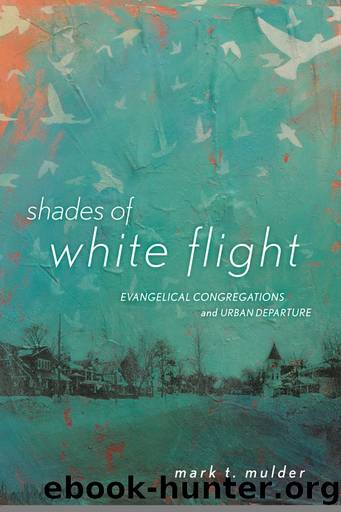Shades of White Flight by Mark T. Mulder

Author:Mark T. Mulder [Mulder, Mark T.]
Language: eng
Format: epub
Tags: Religion, Christian Living, Social Issues, Social Science, Discrimination, Sociology of Religion
ISBN: 9780813564821
Google: MF66oAEACAAJ
Publisher: Rutgers University Press
Published: 2015-01-15T03:21:17+00:00
9
Second Roseland (CRC) Leaves the City
The departures of the CRC congregations from Englewood and Roseland are separated by time (roughly ten years apart) and space (roughly forty city blocks). Three CRC congregations left Englewood 1962â1964, whereas the four in Roseland had departed by 1972. In contrast, the RCAâs congregations in these same neighborhoods remained in their locations longer. The two RCA congregations in Englewood remained until 1973 and 1978, and the four in Roseland left in 1971, 1974, 1977, and 1989. The departures of the CRC congregations will be examined more closely in this chapter, and compared with the moves of the RCA congregations in the next.
In many ways the departures of the seven CRC congregations followed very similar templates. For that reason, I will offer a detailed discussion of the last to leave, Second CRC of Roseland, and its surrounding neighborhood as an exemplar of how a church operating within a congregational framework self-sanctioned a departure from the city. After seventy-nine years of existence in Chicago proper, Second Roseland left for the outlying suburb of Orland Park in 1972.
In an interesting epilogue to the transition, in 1982 Classis Chicago South celebrated the 125th anniversary of the denomination with a worship service and the publishing of a commemorative booklet. Congregations that had once previously been located in Englewood and Roseland discussed their relocations to the suburbs âdue to sociological conditionsâ in the publication.1 Such coded language carefully avoided the racial concerns that precipitated the congregational movement.
CASE STUDY: SECOND CRC OF ROSELAND
As with all CRC congregations, Second Roseland exercised complete control over their location and buildings. The year 1964 seems to have been when the future of Roseland became a concern for the congregation of Second Roseland. During the first half of the year, the council of the 845-member congregation debated the feasibility of modernizing the parsonage. Such an investment displayed an intention to remain.2 However, only a few months later the council reversed course and instead began to consider purchasing a parsonage in âa better neighborhoodââa euphemism for a whiter neighborhood where housing values would presumably remain stable.3 It seems that the leadership of the church had started to worry about the numerous African American arrivals to the community.4
The concern over the neighborhood continued to appear on the agenda of council meetings. In January 1965, the Worship Committee reported to the council their recommendation that all doors of the church be locked five minutes after the beginning of worship services to âsafeguard the property of members.â5 Such a gross violation of fire code indicated a high level of alarm within the congregation. At the same time, the elders engaged in discussions about the future of the CRC in general in the Roseland area.6 These conversations included overtures to the Classis Chicago South and the denominationâs Home Missions Board (a denominational office dedicated to domestic evangelism) about bringing in a missionary to work in Roselandâs âchanging community.â7 Such a request underscored how ill-equipped the congregation felt in reaching out African Americans moving into the neighborhood.
Download
This site does not store any files on its server. We only index and link to content provided by other sites. Please contact the content providers to delete copyright contents if any and email us, we'll remove relevant links or contents immediately.
Getting It, Then Getting Along by L. Reynolds Andiric(631)
Religion and Politics Beyond the Culture Wars : New Directions in a Divided America by Darren Dochuk(451)
Global Justice, Christology and Christian Ethics by Lisa Sowle Cahill(411)
Positive Psychology in Christian Perspective: Foundations, Concepts, and Applications by Charles Hackney(342)
Forgiveness and Christian Ethics by Unknown(329)
Douglas Hamp The First Six Days by Unknown(257)
The Horrors and Absurdities of Religion by Arthur Schopenhauer(243)
Insurgency, Counter-insurgency and Policing in Centre-West Mexico, 1926-1929 by Mark Lawrence(234)
Christian Martyrdom and Christian Violence by Matthew D. Lundberg;(223)
The Oxford Handbook of Greek and Roman Mythography by R. Scott Smith;Stephen M. Trzaskoma;(217)
Beyond Heaven and Earth by Gabriel Levy(210)
God and Eros by Patterson Colin;Sweeney Conor;(208)
The Bloomsbury Reader in Christian-Muslim Relations, 600-1500 by David Thomas;(205)
Autobiography, Volume 2: 1937-1960, Exile's Odyssey by Mircea Eliade(197)
Cult Trip by Anke Richter(194)
Witches: the history of a persecution by Nigel Cawthorne(192)
An Introduction to Kierkegaard by Peter Vardy(179)
The Myth of Disenchantment by Jason A. Josephson-Storm(174)
The Global Repositioning of Japanese Religions by Ugo Dessi(173)
